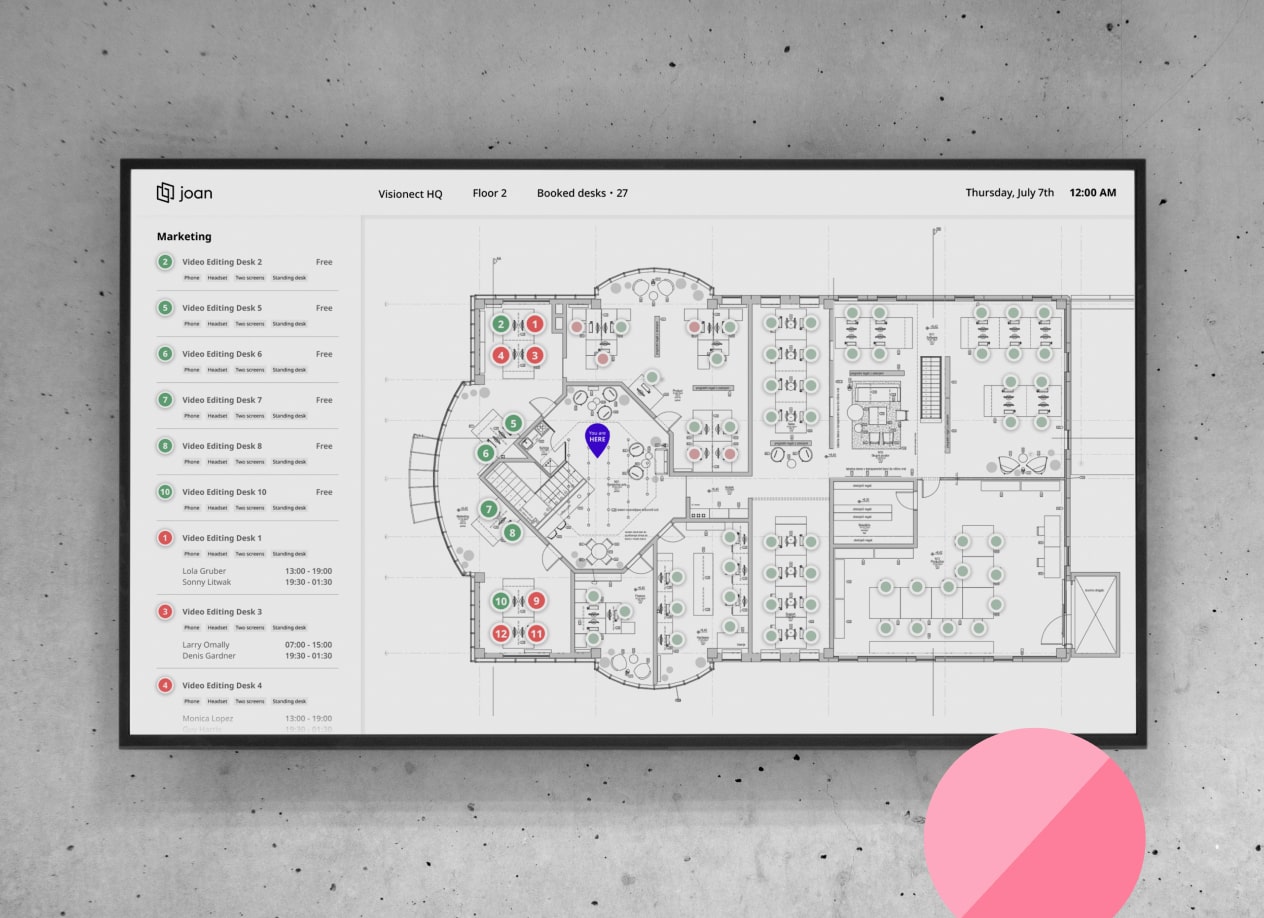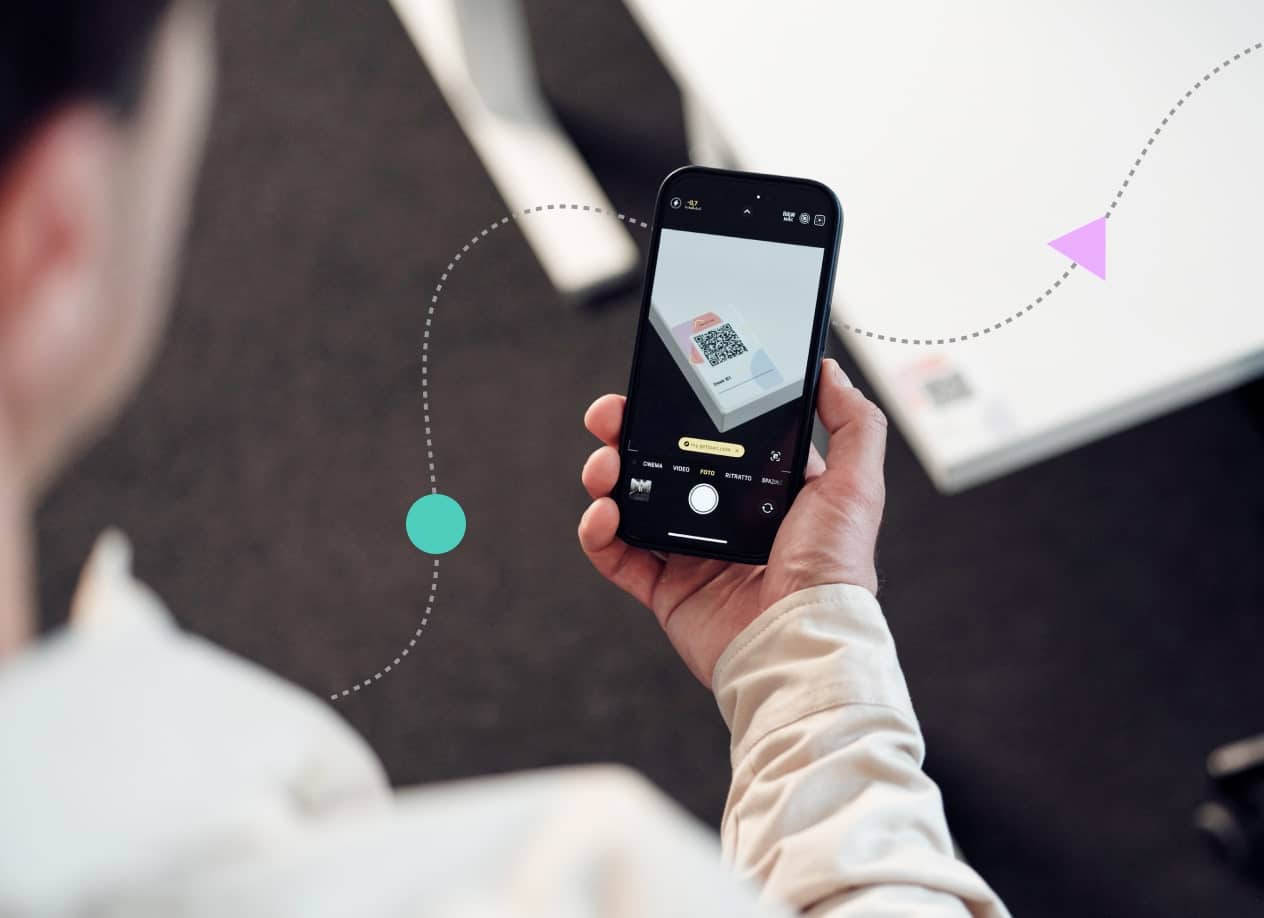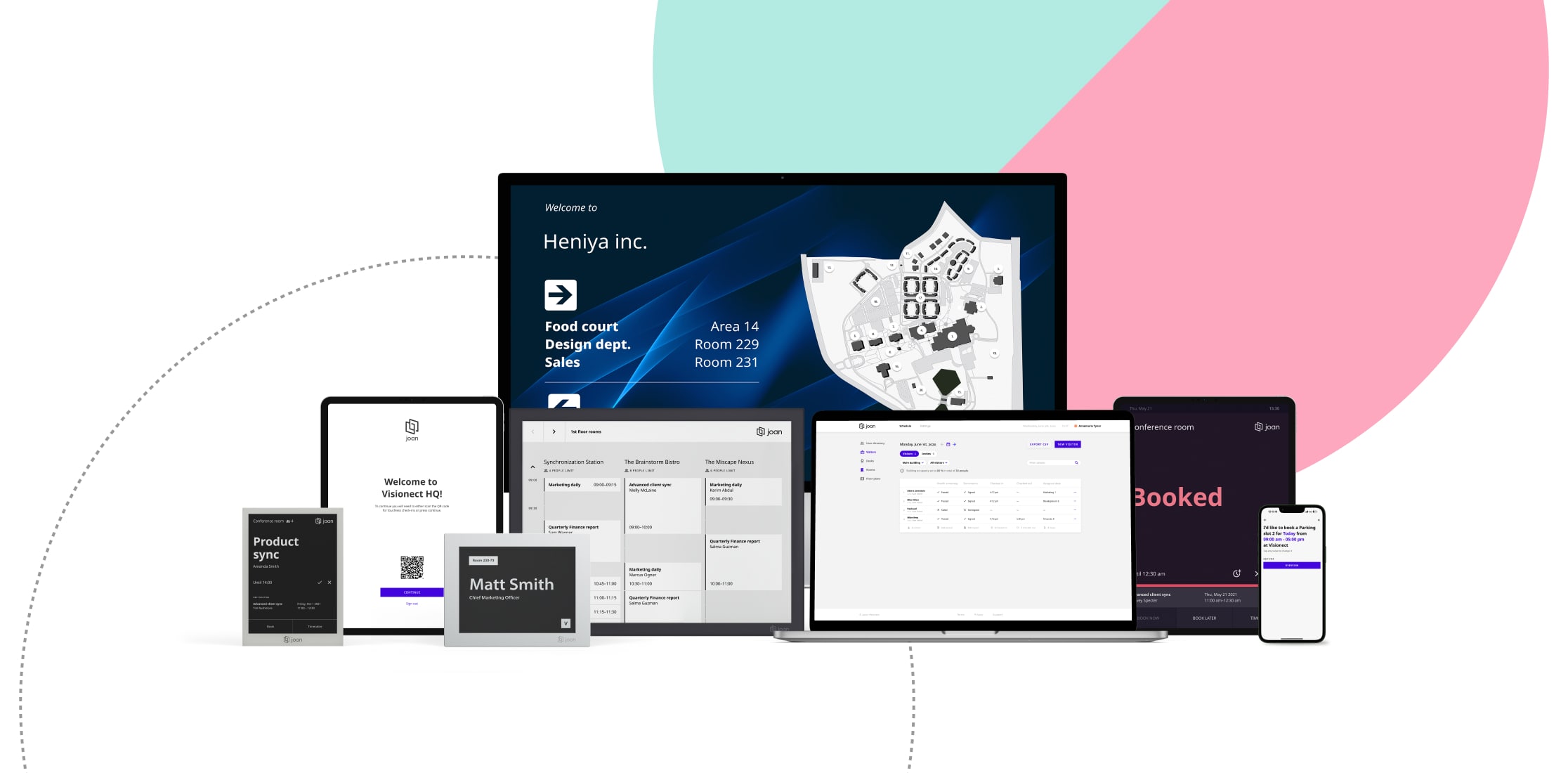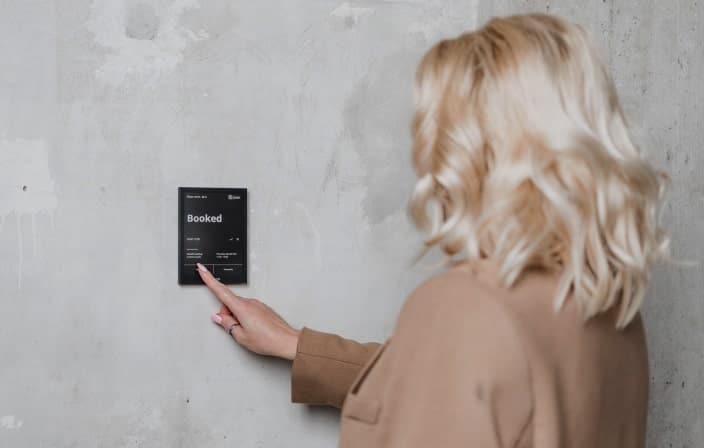build a great workplace
Why Workplace experience matters
A great workplace doesn’t happen by chance. When technology, design, and culture work in sync, people feel connected and motivated. All the tools that shape this experience come together in one place — the all-in-one Joan platform.

The mix of features for your workplace experience
Joan offers a range of features that actively shape your workplace for the better.

Track your air quality and stay healthy
Joan displays come with built-in sensors that track temperature, humidity, and air quality. Use the air quality report to maintain a healthy and comfortable workspace.

NEW: Receive announcements when you’re in the office
This feature adds location awareness to workplace communication. Messages are sent only to people who are in the office on a specific day, via the app and email.

Geolocation check-in
Let your team check in to their desks hands-free as they arrive at the office using geo-location.

Your floorplan dynamics on a big TV
Show your floorplan on a big screen to track bookings, presence, and free spaces — all included in the Joan platform.

Intuitive check-in with QR code and NFC
Book or check in to your desk by simply scanning the QR code on it. No app, no searching. Just scan and you’re ready to work.

Integrations
Joan integrates seamlessly with your existing tools for a smoother, smarter workplace experience.
myjoan portal
Your workplace experience starts here
Create your account in the MyJoan portal and explore every feature that shapes your workplace experience. It’s your hub for testing, managing, and experiencing all Joan solutions in one powerful platform.

Find inspiration for your workplace
Discover what companies like yours love Joan Visitor management solution.
+20 Years of Workplace Experience Taught Me This
We Added 1 Platform And Saved 5 Workweeks A Year
Frequently Asked Questions
What is a workplace experience?
Workplace experience refers to the overall environment, culture, and day-to-day interactions employees have within their organization. It includes everything from office layout and technology tools to the quality of internal communication, leadership, and company culture. A positive workplace experience can increase employee engagement, productivity, and satisfaction.
How can Joan improve the workplace experience?
Joan helps improve workplace experience by simplifying the management of office spaces, reducing friction in daily operations, and enhancing employee satisfaction. It allows employees to book desks and meeting rooms easily, ensuring that they have a comfortable and efficient place to work. Joan helps employees focus on what matters, collaborating, brainstorming, and doing their best work, by eliminating unnecessary distractions, like searching for a free desk or meeting room.
How can Joan help improve workplace culture?
A well-managed office with spaces that are easy to book and accessible to all employees helps foster a workplace culture of trust and collaboration. Joan supports this by:
- Encouraging inclusivity: Employees can easily find spaces that fit their needs, whether for focused individual work or group collaboration, ensuring that everyone’s preferences are met.
- Streamlining operations: By automating and optimizing booking processes, Joan removes administrative burdens from employees and managers, allowing them to focus more on creative and collaborative work.
- Promoting a flexible work environment: Joan’s hybrid work support fosters a more inclusive culture by accommodating both remote and in-office employees in a seamless, integrated experience.
How does Joan help organizations measure workplace experience?
Joan helps organizations track key metrics related to office usage and employee behavior, giving them valuable insights into the workplace experience. The data collected by Joan includes:
- Desk and room utilization: See how often spaces are used and which areas need more (or less) attention.
- Booking trends: Understand peak booking times, helping you optimize office layouts or staffing schedules.
- Employee preferences: Track how employees are using the office to make data-driven decisions on workspace configurations and resource allocation.
These insights allow HR and office managers to identify opportunities to improve workplace design, optimize space usage, and enhance the overall employee experience.
What are examples of workplace experience?
Examples of workplace experience include:
- Office environment: Comfortable workspaces, access to amenities, and the overall atmosphere.
- Technology and tools: Easy-to-use software, fast Wi-Fi, and collaboration tools that enhance productivity.
- Employee benefits: Health programs, flexible hours, and learning opportunities.
- Internal communication: Open channels for feedback, transparent leadership, and regular updates.
- Social culture: Team-building activities, inclusivity, and work-life balance initiatives.
Why is workplace experience important?
A great workplace experience leads to higher employee engagement, retention, and overall productivity. When employees feel valued and have a positive experience at work, they are more likely to stay with the company, contribute their best work, and recommend the organization to others. In a competitive job market, offering a strong workplace experience helps attract top talent.
What makes a great workplace experience?
A great workplace experience is built on several key factors:
- Employee well-being: Providing a healthy work-life balance, wellness programs, and a supportive environment.
- Effective communication: Transparent, clear, and open channels between management and employees.
- Opportunities for growth: Offering training, mentorship, and advancement opportunities.
- Inclusive culture: A workplace that values diversity, fosters collaboration, and encourages innovation.
- Technological support: Tools and technology that empower employees to do their best work efficiently.
How can I improve my office workplace experience?
To enhance the workplace experience in your office, consider the following:
- Gather employee feedback: Regular surveys and one-on-one meetings to understand their needs and concerns.
- Improve physical spaces: Invest in comfortable, flexible workspaces that cater to different working styles (collaboration zones, quiet areas).
- Leverage technology: Use tools like Joan Workplace that streamline workflows and improve communication.
- Encourage inclusivity: Build a culture that celebrates diversity and fosters a sense of belonging for all employees.
How can internal communications improve your workplace experience?
Effective internal communications play a critical role in shaping the workplace experience. Clear and timely communication from leadership helps employees stay informed, reduces misunderstandings, and promotes a sense of alignment with company goals. Tools like internal newsletters, town halls, and collaborative platforms can help employees feel engaged and connected, which improves morale and productivity.
How can technology impact the workplace experience?
Technology plays a key role in transforming the workplace experience by enhancing efficiency, flexibility, and overall employee satisfaction.
With the right workplace management tools, organizations can streamline the process of booking desks, meeting rooms, and collaborative spaces, ensuring employees spend less time searching for available spaces and more time focusing on their work. Real-time availability and easy-to-use digital interfaces allow employees to quickly find the environments they need, whether they’re in the office or working remotely.
These smart systems not only improve communication and collaboration across teams but also foster a more adaptable work environment, supporting both in-office and hybrid work models. By integrating technology that optimizes space usage and simplifies day-to-day tasks, companies can boost productivity, reduce friction, and ultimately create a more positive and efficient workplace experience.
What role does company culture play in the workplace experience?
Company culture is the foundation of the workplace experience. A positive culture that values respect, trust, and inclusivity creates an environment where employees feel motivated and supported. A strong culture encourages collaboration, innovation, and personal growth, all of which are essential for a high-quality workplace experience. When culture aligns with employee values, it leads to greater job satisfaction and retention.
How can hybrid and remote work affect workplace experience?
Hybrid and remote work models significantly impact the workplace experience by offering flexibility and autonomy. Employees appreciate the ability to balance work and life, but it also comes with challenges like communication gaps and isolation. To improve workplace experience in hybrid and remote environments, companies can implement regular check-ins, virtual team-building activities, and ensure the right tools are in place for collaboration and communication.


